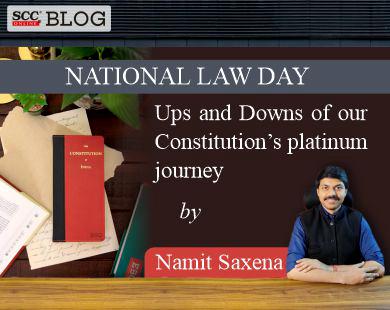This year happens to be the 75th year of attaining independence. This day is particularly more important to us as 72 years back our Constitution was adopted after 3 years of extensive debates by the Constituent Assembly. Interestingly, this Assembly was elected by provincial legislatures under a British Act of Parliament and not through adult suffrage. As per Article 394, 15 articles came into immediate effect and rest on 26-1-1950. Our written Constitution today broadly comprises of Assembly debates, Constitution book and various amendments and the unwritten Constitution can be studied in form of “judicial principles” [derivative (judicial legislations), doctrinal (basic structure, PIL, etc.) and institutional (collegium, SITs, etc.)] and “constitutional conventions” (e.g., appointment of senior most Judge as the Chief Justice of India). Fortunately, unlike Magna Carta, which was almost immediately nullified, our written Constitution has survived several tragic attempts to dilute its influence and the unwritten part has time and again saved democracy.
Attacks on constitutional spirit began right from 1951 when the 1st Constitutional Amendment was passed which in a nutshell intended to evade judicial scrutiny by pushing legislations inside the new 9th Schedule. Notably, this was passed by the same Constituent Assembly which drafted the Constitution as the 1st Lok Sabha elections were conducted in 1952. Its primary agenda was to nullify a judgment of the Patna High Court, wherein one of the agrarian reform legislations was struck down. This, tough unintended triggered an era of conflict over guardianship of the Constitution between the Parliament and the Supreme Court.
After checking land reforms, in landmark judgments, attempts to control press by the Parliament were quashed in Romesh Thappar v. State of Madras1 and Rustom Cavasjee Cooper v. Union of India2 cases. As the Government was inserting legislations in the 9th Schedule whimsically, in 1967, in C. Golak Nath v. State of Punjab3 the Supreme Court held that the Parliament cannot take away fundamental rights and prospectively overruled such legislations. To nullify this, in 1971, 24thand 25th Amendments were introduced. The 24th Amendment stipulated that the Parliament could amend any provisions of the Constitution under Article 368. These amendments were finally partially struck down in Kesavananda Bharati v. State of Kerala4 (1973) and it was held that no amendment can be passed which violates “basic structure” of the Constitution. A 13-Judge Bench was immediately constituted to nullify it, which thankfully could not completely rehear it. However, this did not stop the Government from nationalisation of various sectors and abolition of privy purses of erstwhile rulers. In 1975, during emergency, the 39th Amendment stating that any law made by Parliament before its commencement shall not apply to election of President, Vice President, Prime Minister and Speaker was passed. The Supreme Court quashed it in Indira Nehru Gandhi v. Raj Narain5. The Government then sought to develop a “committed judiciary” and promoted favouring Judges as the Chief Justice twice, by superseding the seniority convention. In another direct attack, the 42nd Amendment was introduced to substantially reduce the power of judicial review of constitutional courts. A number of its provisions were thereafter removed in 43rdand 44th Amendments by the successor Government and few other provisions were quashed in Minerva Mills Ltd. v. Union of India6 (1980).
This forced the judiciary to deinstitutionalise itself from being a “legal institution” and get transformed into a “governing institution”. This led to the advent of public interest litigations and rise of judicial activism. A plethora of cases were decided expanding the ambit of Article 21 to include various fundamental rights and environmental jurisprudence was crafted inside the Constitution itself through judgments in T.N. Godavarman and M.C. Mehta cases. The attempts at luring vote banks in the garb of reservations to public employment and educational institutions continued, and Articles 15 and 16 were interpreted and amended to nullify judgments in Prantiya Vidhyut Mandal Mazdoor Federation v. Rajasthan SEB7 (1992), Union of India v. Virpal Singh Chauhan8 and S. Vinod Kumar v. Union of India9 via the 77th, 85th and 82nd Amendments. In the latest blow to the Constitution an attempt to encroach upon judicial appointments was made via the 99th Amendment to nullify judgments in 2nd10 and 3rd Judges11 cases (1993 and 1998) by drafting NJAC. This amendment has been quashed in the 4th Judges12 in 2015.
The constitutional tension between judiciary and other organs of the State has not yet released itself. Appointments of Judges are being recommended but are confirmed after a considerable time depending upon various factors. The judiciary has been alleged by a particular section of society to have largely compromised with the executive as quite a few judgments have been passed in its favour. While I believe that the tension between the two organs of the State is still going strong, I do not believe that judiciary has been compromised at all.
Our Constitution is a guardian whose two sons (judiciary and legislature) have been at constant slugfest to claim right over it. The founders thankfully inserted Articles 13 and 144 which mandate judicial review and that all three organs have to cooperate with the Supreme Court. It is precisely because of this that the written Constitution though has been erased, rewritten and unwritten, still shines a full moon. Its greatest victory perhaps is that the tolerance interval between “I legislate – You quash – I legislate again” dictum has increased. This day has been notified as the “Constitution Day” by the current ruling establishment. As pen pushers we hope the journey of our constitution, with all ups hereinafter and no downs, keeps on going strong. Fingers crossed!
† Advocate-On-Record, Supreme Court. He can be reached at office@namitsaxena.in
10. Supreme Court Advocates-on-Record Assn. v. Union of India, (1993) 4 SCC 441.
11. Special Reference No. 1 of 1998, In re, (1998) 7 SCC 739.
12. Supreme Court Advocates-on-Record Assn. v. Union of India, (2015) 6 SCC 408







